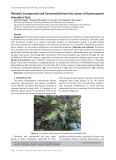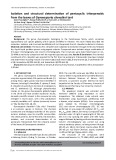
HUE JOURNAL OF MEDICINE AND PHARMACY ISSN 3030-4318; eISSN: 3030-4326
134
Hue Journal of Medicine and Pharmacy, Volume 14, No.6/2024
Isolation and structural determination of pentacyclic triterpenoids
from the leaves of Gymnosporia chevalieri tard
Doan Thi Ai Nghia1,4, Hoang Thi Nhu Hanh2, Le Tuan Anh3, Le Thi Hong Van4,
Vo Quoc Hung1, Nguyen Thi Hoai1, Ho Viet Duc1*
(1) Faculty of Pharmacy, University of Medicine and Pharmacy, Hue University
(2) Faculty of Engineering & Food Technology, University of Agriculture and Forestry, Hue University
(3) Mien trung Institute for Scientifc Research, Vietnam National Museum of Nature, VAST
(4) Faculty of Pharmacy, University of Medicine and Pharmacy at Ho Chi Minh city
Abstract
Background: The genus Gymnosporia, belonging to the Celastraceae family, which comprises
approximately 116 species globally, with 8 species identified in Vietnam. This work initially describes the
extraction, isolation, and structural identification of six triterpenoids from G. chevalieri collected in Vietnam.
Materials and methods: The leaves of G. chevalieri were subjected to extraction through immersion, followed
by a liquid-liquid partition process using organic solvents. Compounds were isolated using a combination of
thin-layer chromatography and column chromatography. Their structures were determined based on 1D-,
2D-NMR as well as by comparison with the reported spectroscopic data. Results & Conclusion: The chemical
constituents of G. chevalieri was reported for the first time. Six pentacyclic triterpenoids have been isolated
and determined including mixture of α-amyrin (1a) and β-amyrin (1b), β-amyrenonol (2), 3-oxofriedelan-29-
ol (3), taraxastane-3β,20R-diol (4), and taraxastane-3β,20S-diol (5).
Keywords: Gymnosporia chevalieri, α-amyrin, β-amyrin, β -amyrenonol, 3-oxofriedelan-29-ol, taraxastane-
3,20-diol.
Corresponding Author: Ho Viet Duc. Email: hvietduc@hueuni.edu.vn
Received: 25/9/2024; Accepted: 14/11/2024; Published: 25/12/2024
DOI: 10.34071/jmp.2024.6.19
1. INTRODUCTION
The genus Gymnosporia (Celastraceae family)
comprises approximately 116 species worldwide [1].
Among these, eight species have been identified in
Vietnam, including G. diversifolia, G. stylosa, G. bonii,
G. chevalieri, G. gracilis, G. marcanii, G. mekongensis,
and G. tonkinensis [2]. Although phytochemical
studies on the genus Gymnosporia globally began
in the 1970s and have yielded impressive results,
domestic scientific interest in this resource has only
emerged in recent years, with a few publications
currently available on G. stylosa (commonly known
as “Dây lóp bóp”) [3], [4], [5].
Gymnosporia chevalieri (“Lõa châu” Chevalier)
is an endemic species in Vietnam. The chemical
constituents and biological activities of this species
remains relatively novel to scientific communities.
This article presents, for the first time, the extraction,
isolation, and structural determination of six
pentacyclic triterpenoids from the n-hexane extract
of the leaves of Gymnosporia chevalieri.
2. MATERIALS AND METHODS
2.1. Materials
The Gymnosporia chevalieri species was collected
in Đakrong District, Quảng Trị Province, in October
2023. The scientific name was identified by Dr. Anh
Tuan Le (Mien Trung Institute for Scientific Research,
Vietnam National Museum of Nature, VAST,
Vietnam). A specimen voucher (GC-01) has been
deposited at the Faculty of Pharmacy, University of
Medicine and Pharmacy, Hue University, Vietnam.
2.2. Methods
The powdered material was extracted with
methanol (MeOH) using maceration at room
temperature. The obtained crude extracts were
fractionated using liquid-liquid partitioning with
n-hexane, ethyl acetate (EtOAc). Pure compounds
were isolated by thin-layer chromatography
(TLC) and column chromatography (CC). TLC was
performed on pre-coated DC-Alufolien 60 F254 and
RP18 F254 plates (Merck, Germany). Compounds were
detected under UV light at wavelengths of 254 and
365 nm or by spraying the plates with 10% H2SO4
reagent followed by heating until color development.
Column chromatography was carried out using
various stationary phases, including normal silica gel
(40–63 µm, Merck, Germany), reverse-phase RP-18
(30–50 µm, Fuji Silysia Chemical, Japan), sephadex
LH-20 and MCI gel (Sigma-Aldrich, USA).
The structures of the compounds were
determined based on ¹H-, ¹³C-NMR, HSQC, and HMBC






















